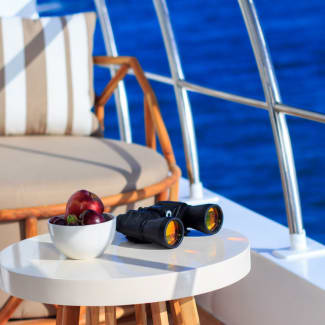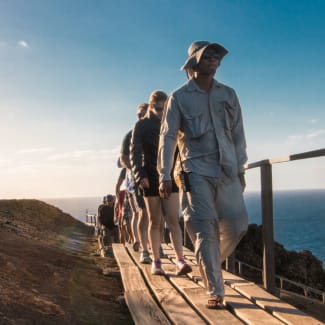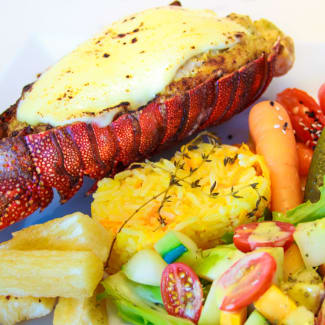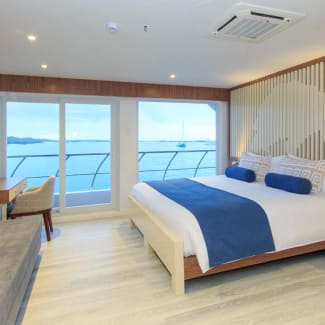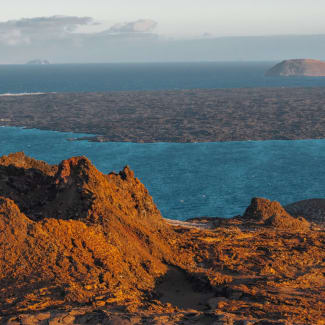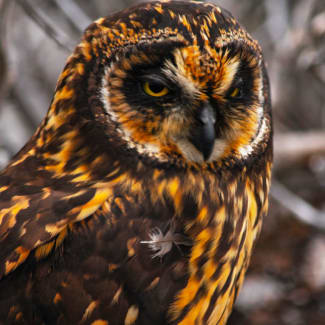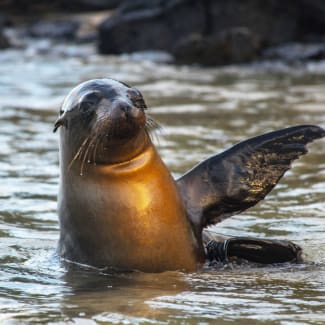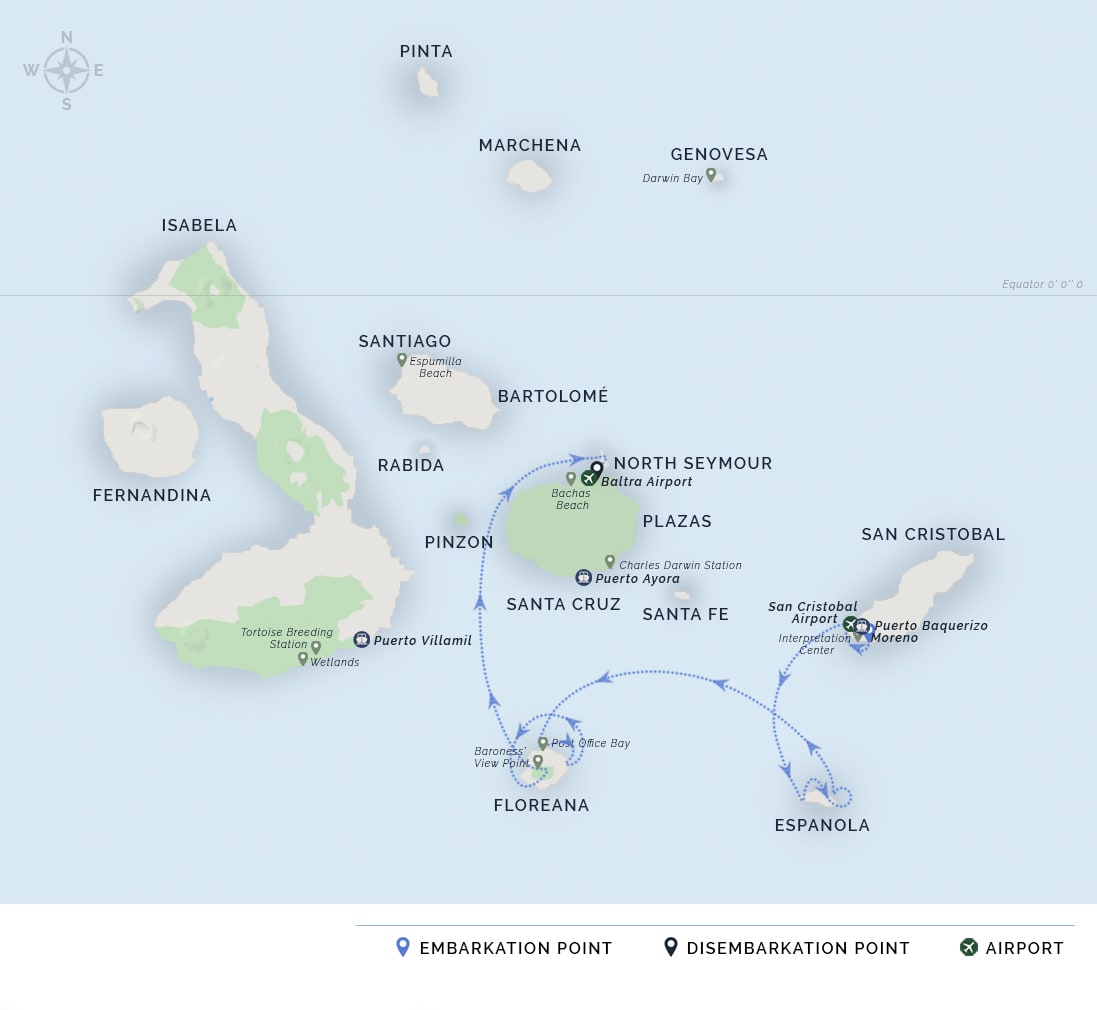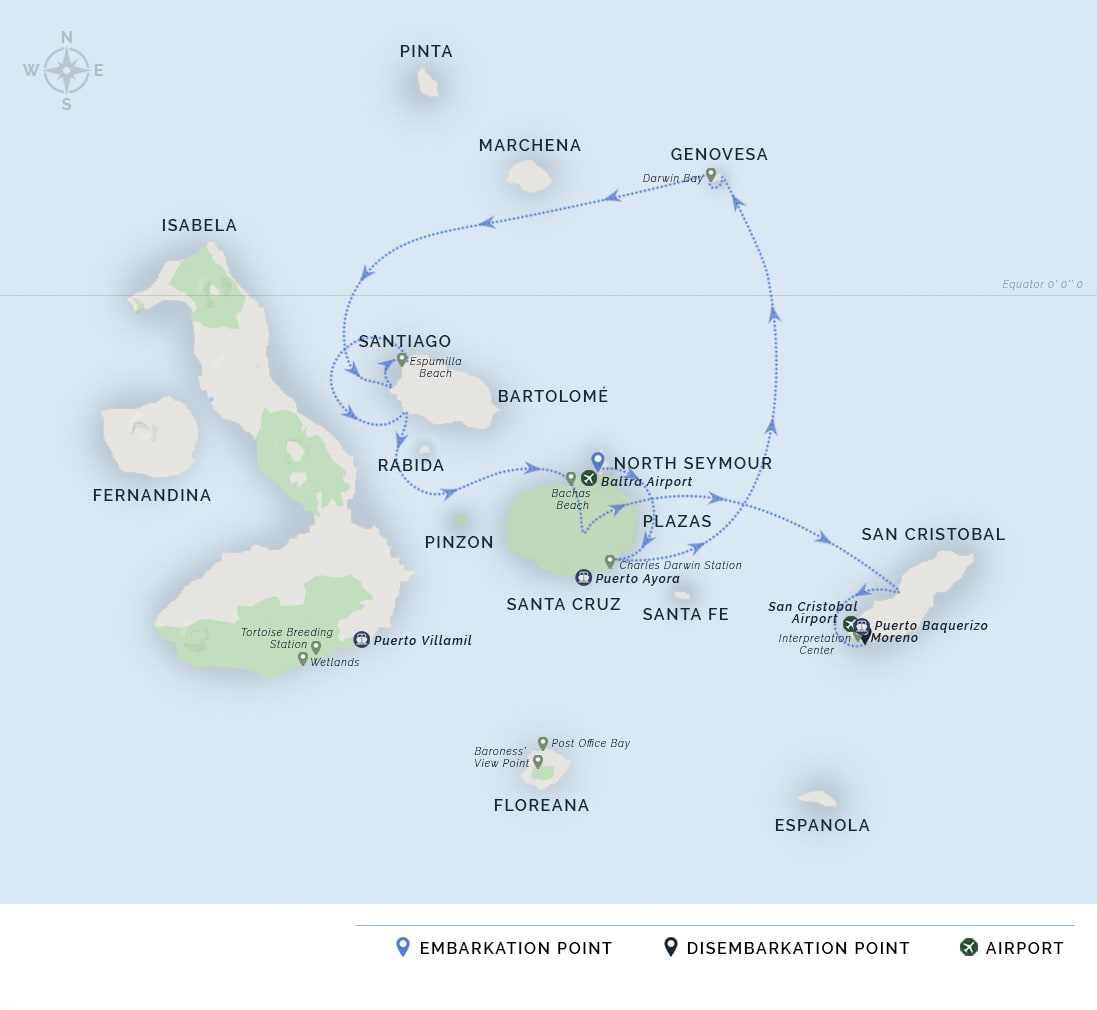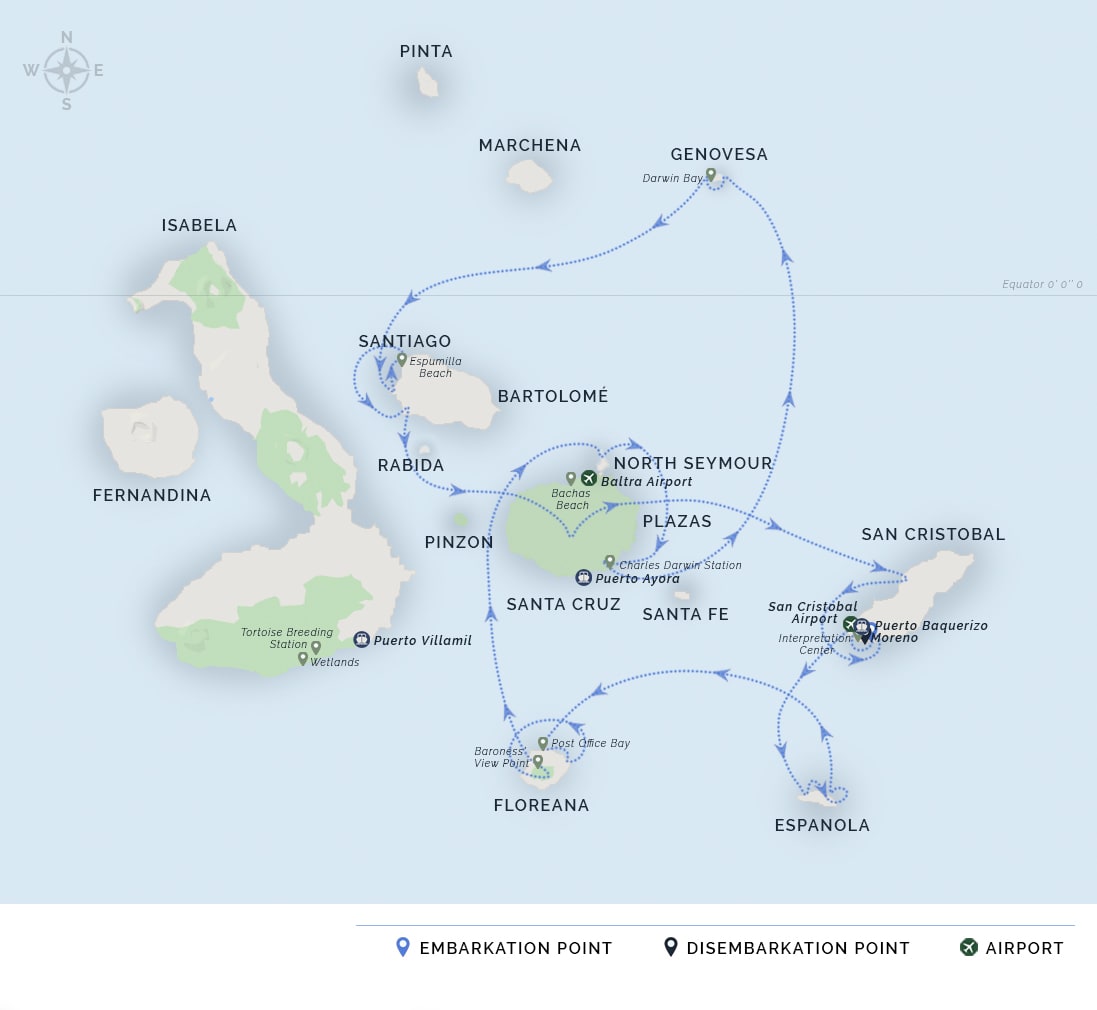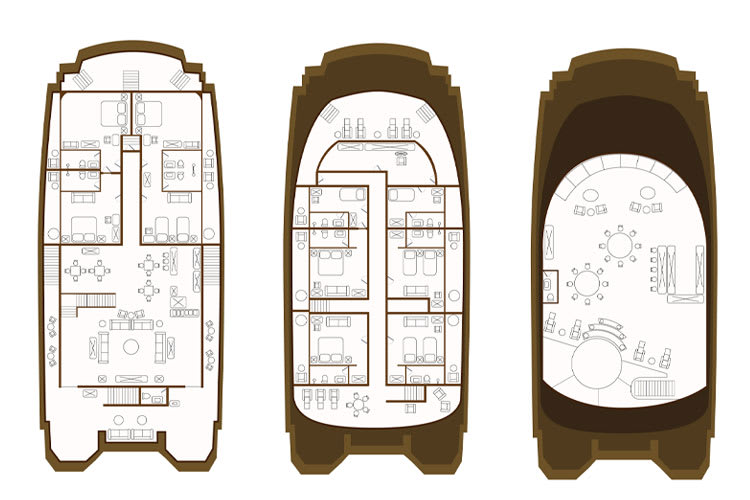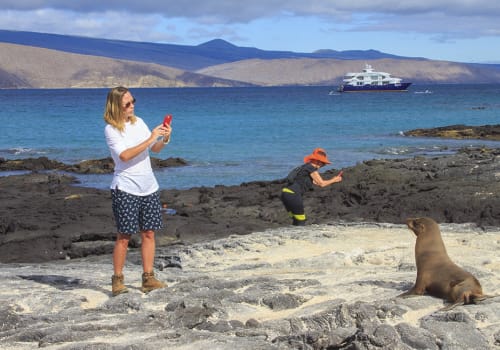Overview
Decorated in deep navy, crisp white, rich wood, with pops of cool ocean tones, the Elite is precisely what you imagine a luxury yacht to be. The 124-foot ship is home to nine cabins and welcomes explorers of all ages.
Life Aboard The Galapagos Elite Yacht
The MC Elite Galapagos is designed to provide a front-row seat to the Galapagos’ natural beauty while encouraging you to indulge in the amenities of an upscale yacht. The nine cabins feature panoramic windows and private balconies, which are perfect spots for sipping your morning coffee or a pre-dinner cocktail. But the place where you spend the bulk of your time is the sky deck. This indoor-outdoor space is partially covered, so it is comfortable all day long.
Spend afternoons sunbathing or watching from the whirlpool as the boat skims toward your next stop. Throughout the day, you will enjoy the finest locally-sourced meals. Breakfast and lunch are casual buffet affairs. For dinner, slip into a seat at the alfresco dining area on the sky deck for an elegant meal while chatting with your fellow travelers.
Excursions From Your Elite Galapagos Cruise
What adventures await you in the Galapagos Islands? The 127 islands within the archipelago are home to some of the most interesting and rarely seen animals on the planet, including blue-footed boobies, marine iguanas, and penguins. The MC Elite Galapagos provides four unique itineraries, all designed to showcase the diverse ecosystem by helping you get up close to as many different species as possible. A range of activities, including paddleboarding, kayaking, snorkeling, and dingy rides, let you experience nature in all-new ways.
During a four-day cruise along the southern islands, stop at Gardner Bay on Espanola Island for a dip in the ocean. With a little luck, a sea lion or two will join in the fun. The five-day cruise explores the eastern islands and includes a stop at Bachas Beach on Santa Cruz island, where you will walk down a sandy beach to a lagoon full of flamingoes.
If you can stay a few more days and want a deeper dive into the Galapagos (and more time to relax on the chic ship), an eight-day cruise may be more to your liking. The eight-day route around the western islands features an opportunity to visit the Arnaldo Tupiza Breeding Center, where giant tortoise eggs are kept safe from predators. A highlight of the eight-day cruise around the eastern islands is a chance to snorkel in Darwin Bay on Genovesa Island in the hopes of seeing sharks and rays.
Welcoming, Knowledgeable Crew
Comfortable, impeccable facilities and exciting excursions are two essential components of an upscale cruise, and the Elite has an ample supply of both. But an enjoyable cruise also relies on a hospitable, expert crew. The team aboard the Elite is made up of the best yachties in the area, and they are delighted to assist in everything you need. The best captains, chefs, and guides in the industry call the Elite home and strive to make each moment of your trip memorable.
The Galapagos’ remote and isolated islands just become much more accessible and comfortable, thanks to the MC Elite Galapagos. The suites, including the single cabin for solo travelers, are spacious and bright, so there is sure to be accommodation to suit your style.
Itineraries & Prices
All itineraries are subject to change due to seasonal weather conditions (and resultant variations in river and tributary water levels) affecting accessibility to locations. Thus navigation routes, times and excursions may need to be modified at the cruise captain’s or your guide's discretion.
Embarkation
AM: Arrive at San Cristobal airport where you will be met by our staff and escorted to the vessel to begin your adventure! We will embark at 12:15 PM from San Cristobal Port.
PM: The Jacinto Gordillo breeding center, named for a renowned environmentalist, is one of a handful of breeding centers in the Galapagos Islands. Located about an hour from the town, the center is home to hundreds of tortoises of different species and ages. The staff at the center have a favorite tortoise: “Genesis,” one of the first ones hatched there in 2005.
The tortoises are raised in a protected environment and eventually released into the wild when they are old enough to be safe from predators and forage for themselves. Through the efforts of the staff at the Jacinto Gordillo center and others like it, hundreds of tortoises have been released and the Galapagos tortoise population is healthier than it has been in decades.
The center is located in an area of low, dense forest, and in addition to the tortoises at the center, it is possible to see several small species of birds flitting about in the vegetation. Look for finches, Yellow Warblers, and Galapagos Doves.
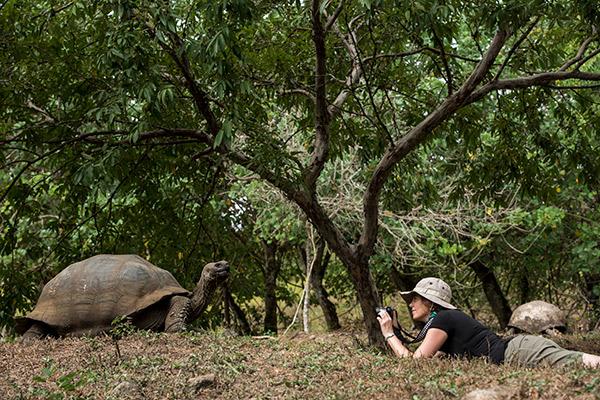
Suarez Point, Gardner Bay, Gardner & Osborne Islets
AM: Universally considered one of the top five visitor sites in all of Galapagos, Suarez Point is an unforgettable hike along the rocky cliffs of the oldest of the Galapagos islands. Birdlife abounds: visitors can hope to glimpse Blue-footed and Nazca Boobies, Red-billed Tropic Birds, Galapagos Doves, and Galapagos Hawks, among others.
The undisputed stars of the site, however, are the Waved Albatrosses. These majestic birds range all over the world but only nest here on Española island. Visitors who come between January and March may not get to see many albatrosses, as they are all far away from feeding, soaring over deep seas. Suarez Point is not only for birds: marine iguanas and lava lizards abound, and lucky visitors will spot a Galapagos Snake or two along the rocky trails.
PM: Gardner Bay features a wide, pristine beach populated by sea lions, crabs, and mockingbirds. Bring your snorkel: you will see some reef fish in the gentle surf off of the island. If you’re lucky, you’ll get to swim alongside playful sea lions! It’s the perfect place to relax after the inspirational intensity of the morning visit to Suarez Point. If the weather and conditions are permitting, the visit to Gardner Bay may be combined with a snorkeling trip to Gardner Islet and/or Osborn Islet, both of which are close to the beach.
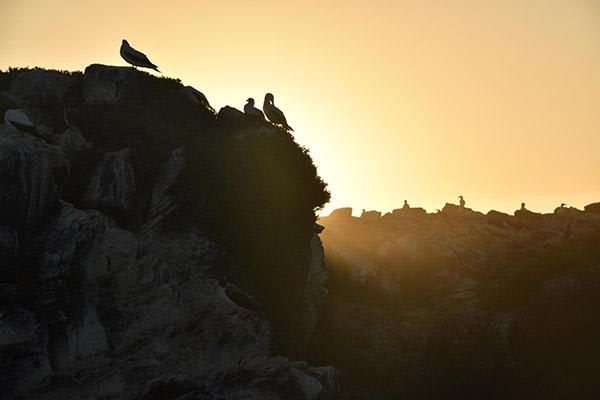
Cormorant Point, Post Office Bay & The Baroness’ Lookout
AM: Cormorant point is a visitor favorite, as it features two memorable beaches, a picturesque walk, and some interesting bird and plant life. Oddly enough, there are no Galapagos Cormorants here, but the flamingos make up for it! Visitors disembark on a sandy beach, which is greenish in color because of the special sand only found here.
A short walk leads to a salty lagoon where flamingos feed and nest. An easy trail leads to a white sand beach on the other side of the point, this one wide and breezy. As you walk, your guide may point out the two species of plants that are only found here: Scalesiavellosa and Lecocarpuspinaffitidus. Lucky visitors will see stingrays in the gentle surf, or even sharks swimming a little further out.
The stingrays make swimming here dangerous, but it is possible to wade in the shallows and take a stroll down the length of the beach. Look for Sally Lightfoot Crabs in rocky areas on both sides of the point. Snorkeling at Champion Islet is considered one of the best places for snorkeling with a great variety of underwater wildlife. It is also the home of Floreana Mockingbird, one of the species in danger of extinction.
PM: Long before the Galapagos Islands were a bucket-list travel destination, it was a common stop for grand wooden seafaring vessels such as whalers. The sailors placed a barrel a short way from a sheltered bay on Floreana Island and used it to drop off and receive letters from home. Today, the yachts that serve the Galapagos are proud to continue this tradition: drop off letters and postcards in the barrel, and some other traveler will deliver them for you! Once you’ve flipped through the letters to see if there are any for your neck of the woods, you can enjoy some sun and sand on the small beach where passengers embark and disembark from the landing craft.
In the early 1930s, Floreana Island was home to Eloise Wehrborn de Wagner-Bosquet, a beautiful young Austrian woman, and her two lovers. Calling herself “the Baroness of Galapagos,” she quickly became an international sensation. She disappeared in 1934, a case that remains unsolved to this day. The visit to the site includes a short panga ride – look for sea life like rays and turtles. There are red mangroves along the shore: these mangroves are crucial to the island ecosystem.
Once on land, a dusty trail bends steadily upwards. The lookout point itself is a rocky hill of rugged volcanic rock, and there is indeed a good view from there, a reward for those who scramble to the top. A short walk away is the ruins of an old biological station, which were likely used in 1934 when some passing filmmakers made a short film starring the Baroness herself.

Disembarkation
AM: Located between the islands of Baltra and North Seymour, Mosquera is one of several tiny islets in the Galapagos. Sandy and rocky, it is not home to much in the way of vegetation, but it is very popular with sea lions and birds, including gulls. You can also expect to see marine iguanas sunning themselves on the rocks and colorful Sally Lightfoot crabs scuttling about in the tidal pools. Shorebirds are fond of the island: look for them trotting along the beach. There is some good snorkeling around Mosquera and dive shops in Puerto Ayora sell day trips there.
We will disembark from the cruise at 8:00 AM from Baltra Port. After our early morning visit, passengers will get ready and then be taken to Baltra Airport, crossing the highlands of Santa Cruz Island by car. Our airport personnel will assist passengers with the check-in process. Farwell and boarding the flight back to mainland Ecuador.
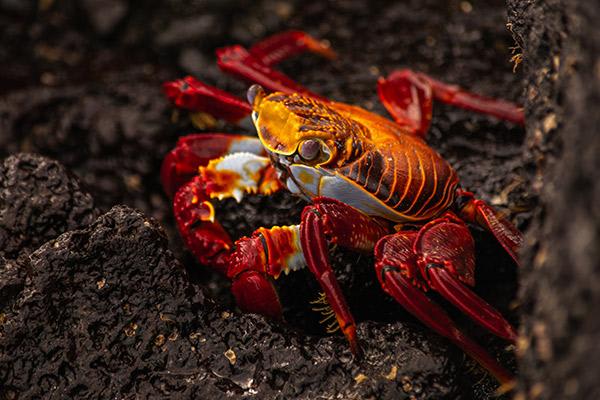
Embarkation
AM: Arrival at Baltra Island Airport. Reception and Assistance at the airport by our members and transportation to our first visitor site.
PM: The Fausto Llerena Giant Tortoise Breeding Center is managed by the Galapagos National Park Service and biologists from the Charles Darwin Research Station. The purpose of the center, named for a legendary park ranger, is to raise Galapagos tortoise hatchlings in a protected environment. When the tortoises are large enough to fend for themselves, they are released into the wild. The program has been a great success and in recent years hundreds of young tortoises have been released on several islands.
You will see different sub-species of tortoises in various species of development, from tiny young ones smaller than your fist to fully-grown behemoths lumbering about their enclosures. Your guide will accompany you and provide information about the programs and facilities.
The breeding center is located at the Charles Darwin Research Station, just outside of the town of Puerto Ayora. In addition to the tortoises, you may see finches, warblers, and other birds in and around the tall tree cacti, and tiny lava lizards scurrying about underfoot. After visiting the Research Station, passengers will be taken to the Puerto Ayora pier to board the M/C Elite.
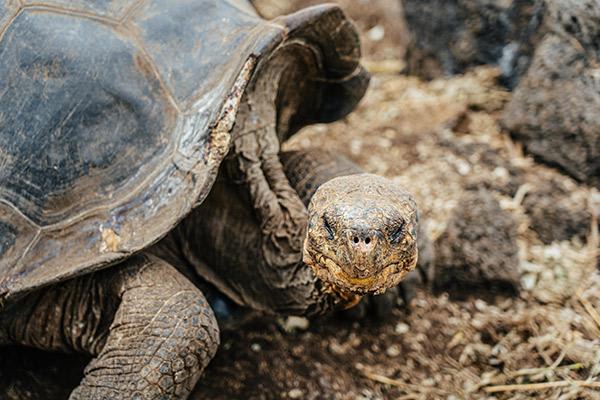
Prince Philip's Steps, El Barranco & Darwin Bay
AM: Genovesa Island is famous for birdlife and neither of its two visitor sites disappoints. Genovesa is the remnant of a once-mighty volcanic crater, and the island still has a distinctive crescent shape. The body of water formed by the crescent is called Darwin Bay, in spite of the fact that Charles Darwin did not ever visit this particular island.
There are no large land animals on Genovesa: not even tortoises or land iguanas. Unlike other islands, Genovesa never had a problem with destructive introduced animals like feral cats or goats, which has allowed birdlife to thrive unmolested on the island for millennia. In the morning, you will visit the Prince Philip’s Steps site. Getting to the visitor site from the landing area is tricky and involves a bit of climbing skill, but once you’re up, Prince Philip’s Steps is a visitor favorite.
There is a magnificent view from the upraised plateau, especially on a clear day. An easy trail winds through a low, scrubby forest and ends up at a rocky ravine of sorts, where lucky visitors will spot the rarely-seen Short-eared Owl. Visitors may also see Red-footed Boobys, gulls, or other birds nesting or visiting the site.
PM: The Darwin Bay visitor site is on the interior side of the crescent-shaped island, protected from wind and currents. It is a wide, sandy beach with a short trail that leads off to one side of the beach and up into some rocky formations. There are many bird species here: visitors can expect to see Blue-footed Boobys, Frigate Birds, Lava Gulls, Herons, Swallow-tailed Gulls, and more.
It is one of the few visitor sites in the islands where you can see Red-footed Boobys. There are some tidal pools off the trail: lucky visitors may spot a ray or some fish trapped there until the tide returns. Following the visit, guests will get to snorkel in the sheltered waters of the bay. Although deep water currents can sometimes cause the water to be chilly or cloudy, the crescent shape of the island protects the bay from strong winds.
The bluffs along the side of the bay drop sharply into the water, which means that snorkelers can stay close to shore but still have deeper water off to one side. Lucky snorkelers might see sharks, rays, sea lions, sea turtles, and dazzling reef fish including parrotfish, wrasses, king angelfish, and damselfish.
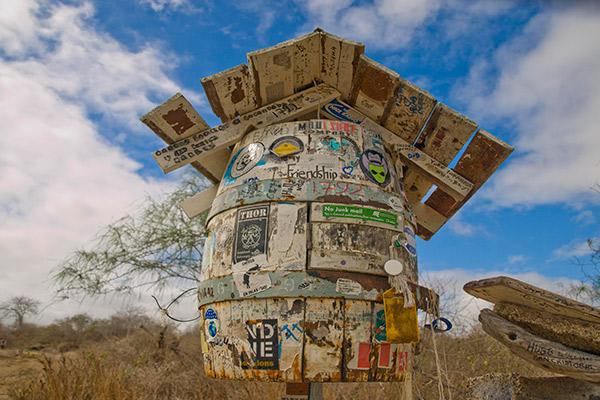
Buccaneer Cove, Espumilla Beach & Egas Port
AM: Back in the days of the great sailing ships, the Galapagos Islands were well known as a place where a traveling ship could stock up on food and water. Among the visitors were pirates, and the sheltered bay now known as Buccaneer Cove was a favorite place for them to repair their ships. Your visit includes a panga ride along the coast, where guests will see some interesting rock formations as well as several species of nesting birds including gulls, boobys, and pelicans. The formations, eroded into the colorful red rock, are quite striking. You may get to see not only sea lions but also their more reclusive cousins, the Galapagos Fur Sea Lion. The panga ride is followed by a visit to unforgettable Playa Espumilla (“Foamy Beach” in English). The beach, known for reddish sand, is a favorite among guests: long, pristine, and beautiful, it is home to a colony of sea lions as well as countless crabs and marine iguanas. It is possible to do some light snorkeling off of the beach.
PM: The human history of the Galapagos Islands is often as interesting as the natural history, and a good example is Port Egas. Decades ago, an Ecuadorian named Hector Egas tried to make his fortune mining salt on Santiago Island. It worked for a while, but in the end, the enterprise failed. Port Egas bears the name of this intrepid entrepreneur, and there are still some remnants of the old salt mine facilities here if you know where to look.
Puerto Egas is a superb visitor site even without its history. The trail is a loop that goes through some low trees before swinging around along the coast. Along the inland part of the trail, look for finches and a medium-sized blackbird: this is the Smooth-Billed Ani, an introduced species which somehow arrived in Galapagos at some point in the 1960s. On the coastal portion of the trail, you can expect to see numerous sea lions, marine iguanas, and shorebirds.
The coast is rocky due to its volcanic formation, but easy enough to walk along. Look in the shallow tidal pools: you never know what might have gotten stranded in there when the tide went out, and you might spot a stingray or an octopus in addition to the small fish usually found there.
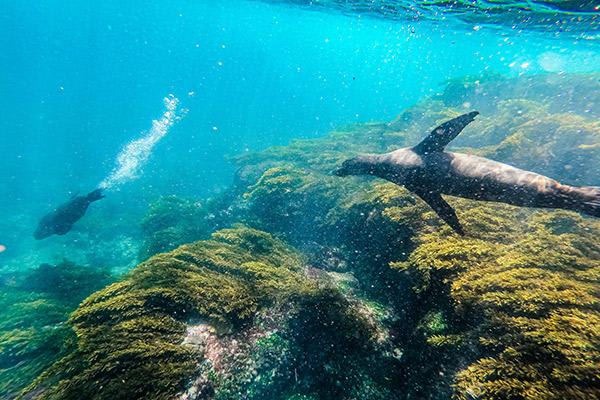
Bachas Beach, Twin Craters & Santa Cruz Highlands
AM: Bachas beach is one of the more beautiful ones in all of Galapagos – and that’s saying something. It is a long stretch of pristine white sand where sea lions lounge and crabs scuttle back and forth. It was used by the Americans during World War Two: “Bachas” is a version of the word “barges,” which were once landed here.
Sea turtles nest in some of the dunes here, and your guides will ask you to stay clear of the marked areas so as not to disturb the eggs. A short distance away are two salty lagoons where flamingos are frequently seen. There is no real hike here: only the warm, sandy beach. After a stroll along the sand and a refreshing dip, some of our guests like to do some easy snorkeling in the gentle surf.
PM: The Twins: The “twins” are a pair of sinkholes located in the highlands of Santa Cruz Island. Created ages ago by collapsing lava tunnels, they are not far from the main road through the highlands. From the parking lot, it is a fun, easy hike through a lush tropical forest to the walkways which ring the top of the sinkholes. Butterflies and smaller birds such as finches, doves, and mockingbirds dart and flit through the dense forest on either side of the trail, and attentive visitors may spot the distinctive red flash of a vermillion flycatcher as well.
You will stay in the highlands of Santa Cruz island to see giant tortoises in the wild. This impressive animal gives the name to the archipelago. You can easily appreciate the Galapagos giant tortoises in their natural habitat, eating, walking among others. This is also a good place to see birds such as short-eared owls, Darwin’s finches, yellow warblers, Galapagos rails, and paint-billed crakes. As part of this experience, you will visit underground lava tubes formed by cooled and solidified lava. Then we will continue our journey to board the M/C Elite.

Disembarkation
AM: They say your culture influences the way you look at things, and Kicker Rock may just be the proof of that. Kicker Rock is a distinctive, boot-shaped rock formation located off of San Cristobal Island. In English, it gets its name from this shape. In Spanish, its name is “León Dormido,” or “Sleeping Lion.” Does it look more like a boot or a lion? You’ll get a nice close-up chance to look for yourself and make up your mind. Your final visit to the Galapagos Islands will be a memorable one: a panga ride up to and around the rock, with the chance for some snorkeling as well. The snorkeling here is excellent, although the currents can be rather strong. Hammerhead sharks are often seen in the murky depths around kicker rock, and fortunate snorkelers might even see a large ray or two.
We will disembark from the cruise at 8:00 AM from San Cristobal Port. After our early morning visit, passengers will get ready and then be taken to San Cristobal Airport. Our airport personnel will assist passengers with the check-in process. Farwell and boarding the flight back to mainland Ecuador.
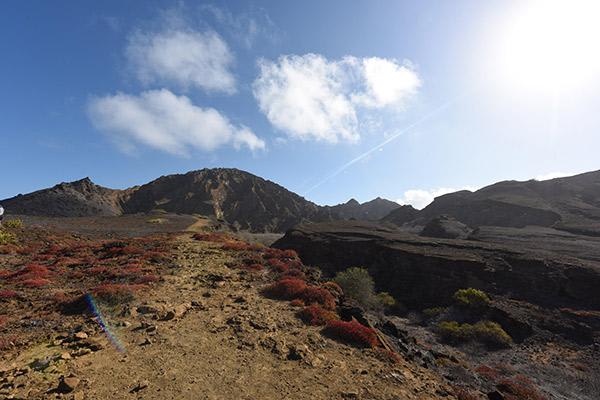
Embarkation
AM: Arrive at San Cristobal airport where you will be met by our staff and escorted to the vessel to begin your adventure! We will embark at 12:15 PM from San Cristobal Port.
PM: Walk up the rocky path surrounded by rich vegetation and wildlife to the rim of the El Junco Lagoon, an impressive crater lake located in the highlands of San Cristobal island. Here you will enjoy superb panoramic views of the island, and you can often catch frigate birds diving and bathing in the crystal clear water below.

North Seymour Island & Dragon Hill
AM: North Seymour is a visitor favorite, packed full of the sorts of animals that people have come from around the world to see. After a brief scramble up a rocky bluff from the landing site, the trail is more or less flat, although quite rocky in places. The trail winds through some scrubby vegetation before looping around and returning to the landing site via a picturesque beach. The star animal here is the land iguana, which is seen at only a handful of visitor sites.
There is a species of cactus here that the iguanas like to eat, so look for them near cacti, munching on the pads. Look for nesting Frigate Birds in the trees along the trail. Mating season for the North Seymour Frigate Birds is between March and June, and those are the best months for seeing the bright red neck pouches for which the birds are famous, but there always seems to be one or two rogue frigates who inflate theirs at other times of the year. On the ground, Blue-footed Boobys abound, squawking at visitors from their dusty nests on and near the trail. There is a healthy colony of sea lions near the landing site and along the beach, and you’ll also see marine iguanas and the ubiquitous Sally Lightfoot crabs there. After the visit, your guides may take you snorkeling nearby: lucky visitors may see sharks, eels, or rays in addition to the usual colorful reef fish.
PM: Depending on who you ask, Dragon Hill (“Cerro Dragon” in Spanish) gets its name either from the fact that it is shaped roughly like a sleeping dragon or from the fact that it is home to many land iguanas. Both explanations work: from afar, if you squint just right and have a good imagination, it can look like a dragon, and the iguanas here make the site a visitor favorite.
Dragon Hill is one of the longer hikes in the Galapagos. It winds through a maze of Palo Santo trees and prickly cacti before ascending the hill itself. The hike is desert-like, especially during the drier months of the year. Look for the little dragons – the land iguanas – near the trail, munching on cactus pads. Part of the hike will take you past a salty lagoon, where sometimes flamingoes can be seen. Look for Pintail Ducks and stilts there, too. Darwin Finches and mocking birds flit through the trees, and you may see a Galapagos Dove or two waddling along the trail, pecking away at nearly-invisible seeds on the dusty ground. The trail eventually reaches the top of Dragon Hill, from where there are a fantastic view and the opportunity to do snorkeling.
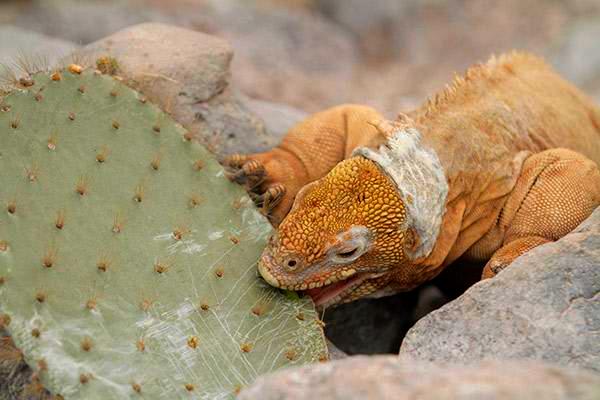
Tintoreras, Sierra Negra, Isabela Wetlands & Arnaldo Tupiza Breeding Center
AM: Tintorera is the local name for the White-tipped Reef Shark, but can also refer to an area off of Isabela Island where there are many very small islands and semi-submerged rocks in a small area. This area is well-known for abundant wildlife: in addition to the sharks, there are countless marine iguanas sunning themselves on the rocks. Penguins live here, too, Blue Footed Boobys nest on the larger rocks, and islets and brown Pelicans splash into the sea to devour a bill-full of fish.
There is a certain shallow channel that the sharks seem to like: at times it is possible to see dozens of them there. Alternatively, Sierra Negra is an interesting hike. Sierra Negra, on Isabela Island, is the only volcano currently open to hikers. A group of fit hikers with a guide can do the trail in about five to six hours. The trail itself is not dangerous or particularly steep, but the sun can be strong and groups should be well provisioned with water, sunscreen, and other protection against the elements.
The trail to the top is a memorable one because it passes through different zones. Near the base, the vegetation is lush and green, and small birds are common, but later it gets rockier as it passes through some areas of dried lava. The view from the top of the volcano is stunning: visitors get to see the volcano caldera as well as an unforgettable seascape.
PM: A short walk from Puerto Villamil, the only town on Isabela Island, the Arnaldo Tupiza Breeding Center is a visitor favorite. The center specializes in the five subspecies of giant tortoise native to the island of Isabela, the largest in the Galapagos. Adult tortoises were brought to the center to reproduce in a safe environment where eggs and young tortoises could develop away from predators. The center has been very successful, and even the Cerro Paloma tortoise subspecies, once on the brink of extinction, are now healthy once more.
The center itself is shady and airy and has a garden-like feel to it. Visitors stroll around at their leisure, snapping photos of the tortoises and asking questions of their guides. There are interesting species of trees here, too: look for signs or ask your guide about them. The trail from the town to the breeding center is part of the fun: it goes through a marshy lowland and parts of it are on raised boardwalks so that visitors will not disturb the fragile ecosystem. Look for wading and swimming birds like Pintail Ducks and egrets.
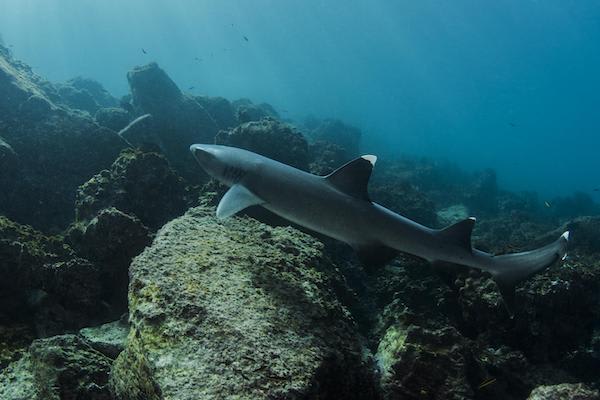
Moreno Point & Urbina Bay
AM: Punta Moreno is an excellent site for fans of geology and bird lovers. The ground is covered in rough lava, dried out after an eruption decades ago. The formations of the lava rock indicate how it flowed and dried and are very interesting for geologists. The lava flow cooled unevenly, and in places, there are little ponds of brackish water popular with wading birds like flamingoes, herons, and stilts. You may even get to see the occasional Pintail Duck in one of the pools! There is little in the way of vegetation, but some hardy pioneer plant species and cacti have begun the process of breaking the lava rocks down into something friendlier for plants and animals. There are small lizards and snakes to be found in and among the rocks. Along the coastline, tidal pools may trap some interesting sea life, and you may get to see some marine iguanas swimming and diving down to feed on underwater algae. Also snorkeling along the shoreline, lucky guests may spot some Galapagos Penguins.
PM: Isabela Island is still acutely active, geologically speaking, and lucky guests may even get to witness an eruption: these happen every five years or so. One day, about fifty years ago, volcanic activity deep under the earth rocked Isabela island, reshaping the contours of Urbina Bay. Today, one of the more fascinating trails in the islands wends its way through the rocks and trees of Urbina Bay. Massive chunks of coral still stand where they were when the land rose out of the sea. In and around the trail, it is possible to see land iguanas and smaller birds like finches, and the occasional giant tortoise lumbers across the trail in front of astonished visitors.
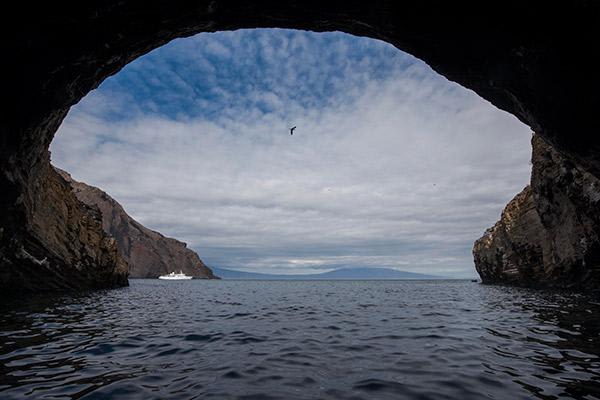
Espinosa Point & Vicente Roca Point
AM: Years after your trip, many of your favorite photos will have been taken here on Espinosa Point. Hundreds of marine iguanas bask in the sun near the landing point: sharp-eyed guests may even spot some swimming in the surf, ready to dive down and gnaw some algae off of the rocks offshore. Galapagos hawks soar overhead, looking for a meal, or stare, stony-eyed, at visitors from their perch in a tree. At the end of one of the trails, flightless cormorants – a species unique to the islands – make their nests and clumsily waddle around. In the gentle surf off the point, monstrously large sea turtles surface, gulp a mouthful of air, and sink again. Some visitors will spot the shy Galapagos snakes slithering between the cracked lava rocks. Tidal pools have been known to capture large stingrays, which then must await the next tide to escape to the sea again. Geology buffs will marvel at the lava formations which make up the rugged ground here. Unforgettable!
PM: Vicente Roca Point, on the rocky coast of Isabela Island, is not a walking tour. The visitor site is the coastline itself: rocky and pounded by the surf. Pangas keep a safe distance from the treacherous waves, making their way along the coastline. Visitors can expect to see both varieties of sea lions native to the Galapagos: the Galapagos Sea Lion and the Fur Sea Lion. Also, lucky guests may see penguins along the rocky shore and any number of sea birds nesting along the cliffs and soaring overhead. The snorkeling is excellent here: the guides will pick the best spot depending on the conditions, and guests have the possibility of seeing sea lions, penguins, and turtles also the usual parrotfish, surgeonfish, sergeant-majors, and other stars of the Pacific reefs.
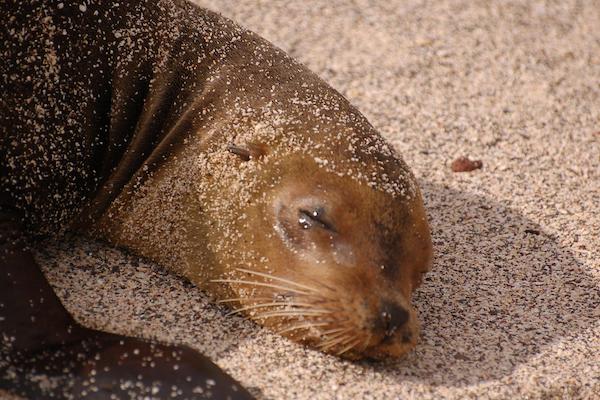
Rabida Island & Bartholomew Island
AM: This morning’s visit has something for everyone! Rabida is a smallish island with an unforgettable trail. Visitors disembark on a beach where the sand is a startling shade of crimson. This is due to the high iron content of the soil and sand. If you walk along the red, sandy beach, you may observe Brown Pelicans nesting in the mangroves and trees. Behind a wall of mangroves is a shallow, salty lagoon where flamingoes occasionally feed. The main trail meanders up a small hill, through rocks, fragrant palo santo trees, and cacti, eventually reaching a scenic rocky cliff. In addition to the pelicans, flamingoes, and the occasional booby, Rabida is known for smaller birds: visitors should look for Finches, Galapagos Doves, Yellow Warblers, and Mockingbirds.
Following the walk, guests will have the opportunity to snorkel at a spot not far from the beach. Rabida is a favorite snorkeling spot: guests are dropped off where a steep cliff goes into the water. As you swim along the coastline, on the one side there are rocks where colorful reef fish dart about, and on the other side is deepish water where the occasional shark or ray can be seen. Sometimes, playful sea lions will approach snorkelers for a closer look! The snorkeling site is mostly sheltered from the wind and currents which can make snorkeling in other places in the islands challenging.
PM: Bartholomew (Bartolomé in Spanish) Island is one of the more picturesque visits on the itinerary. Bartholomew is a smallish island, located a short distance from the larger Santiago (James) island nearby. The island was once a volcanic cone, but much of it has eroded away. Near the landing site, look for marine iguanas, Sally Lightfoot Crabs, herons, and Galapagos Penguins. There is a trail to the top of the cone, from which there is a fantastic panoramic view of the azure waters and misty hills of Santiago Island. The trail consists of a boardwalk with many stairs. The boardwalk is there to protect the fragile ecosystem of the island. There is little wildlife along the trail: look for lava lizards and insects scurrying about.
At the western end of the island, Pinnacle Rock looms over the placid waters of Santiago Bay. Pinnacle rock, which looks like a massive chipped Stone Age spear point, stands out from the rounded hills of Bartolome and Santiago: legend has it that the distinctive formation was created during World War Two when the United States Navy used the island for bombing practice.
Following the steamy hike to the top and back down again, what better than a refreshing swim? Bartholomew is one of the premiere snorkeling spots on the islands. Visitors may see any combination of penguins, sharks, rays, and sea turtles in addition to the usual colorful kaleidoscope of reef fish.
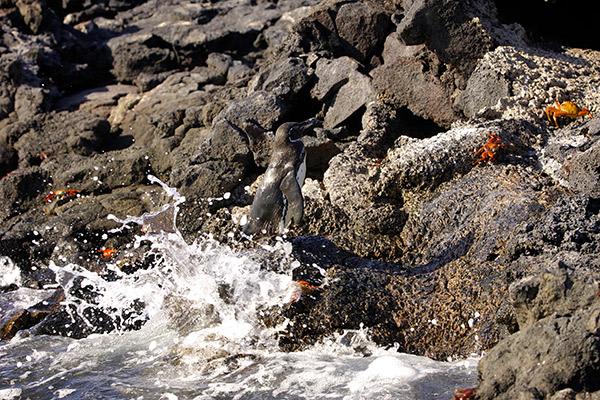
Witch Hill & Lobos Island
AM: Witch Hill gets its name from the Vermilion Flycatcher, a small bird with dazzling red plumage. In Spanish, it is called “pájaro brujo,” or “witch bird,” and the rugged hill at this site was once known for the population of Vermilion Flycatchers that lived there. The birds are not as common here as they once were, although they are still plentiful elsewhere in the islands. The Witch Hill visitor site features one of the best beaches in the Galapagos, a small lagoon where visitors may see egrets and herons, and some excellent light snorkeling. Generally, part of the visit includes a panga ride around the unique rock formations of Witch Hill itself. Sea lions snooze on the beach and nesting boobies quark and whistle at visitors from the rocks. The waters here are particularly lively: look for shorebirds darting along the waterline and poking around in tidal pools, boobies fishing offshore and pelicans splashing noisily in search of a bill-full of fresh fish. There is a spectacular view of picturesque Kicker Rock from the beach.
PM: Isla Lobos, or “Sea Lion Island,” is a long, thin island not far off the coast of San Cristobal Island. As the name implies, it is home to a healthy colony of sea lions. There is a trail on the island, and visitors can see different species of birds, including Boobys of both the Blue-footed and Nazca varieties. There are marina iguanas and lava lizards on the island as well. In addition to the hike on the islet, the calm channel between Lobos Island and San Cristobal is one of the better snorkeling spots in the islands, as it is usually calm and the sea lions often frolic with visitors.
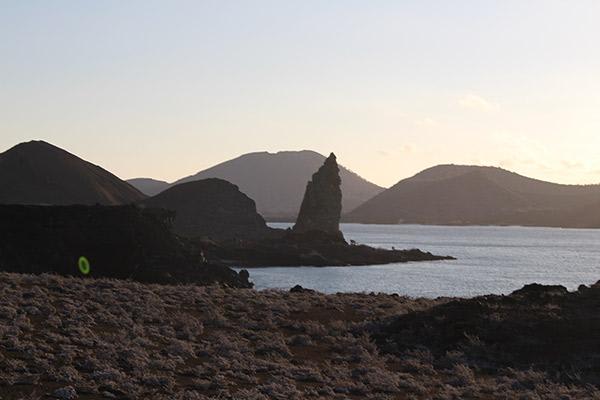
Disembarkation
AM: Built in 1998, with the support of the government of Spain and the Charles Darwin Research Station, the San Cristobal Interpretation Center features exhibits on the natural and human history of the Galapagos Islands. There are displays and photographs, with descriptions in English and Spanish. The exhibits document the different phenomena that make the islands so unique: one example is an excellent description of the different ocean currents that seasonally affect all life on the islands.
We will disembark from the cruise at 8:00 AM from San Cristobal Port. After the visit to the Center, passengers will be then taken to San Cristobal airport. Our airport personnel will assist passengers with the check-in process. Farwell and boarding the flight back to mainland Ecuador.

Embarkation
AM: Arrive at San Cristobal airport where you will be met by our staff and escorted to the vessel to begin your adventure! We will embark at 12:15 PM from San Cristobal Port.
PM: The Jacinto Gordillo breeding center, named for a renowned environmentalist, is one of a handful of breeding centers in the Galapagos Islands. Located about an hour from the town, the center is home to hundreds of tortoises of different species and ages. The staff at the center have a favorite tortoise: “Genesis,” one of the first ones hatched there in 2005.
The tortoises are raised in a protected environment and eventually released into the wild when they are old enough to be safe from predators and forage for themselves. Through the efforts of the staff at the Jacinto Gordillo center and others like it, hundreds of tortoises have been released and the Galapagos tortoise population is healthier than it has been in decades.
The center is located in an area of low, dense forest, and in addition to the tortoises at the center, it is possible to see several small species of birds flitting about in the vegetation. Look for finches, Yellow Warblers, and Galapagos Doves.

Suarez Point, Gardner Bay, Gardner & Osborne Islets
AM: Universally considered one of the top five visitor sites in all of Galapagos, Suarez Point is an unforgettable hike along the rocky cliffs of the oldest of the Galapagos islands. Birdlife abounds: visitors can hope to glimpse Blue-footed and Nazca Boobies, Red-billed Tropic Birds, Galapagos Doves, and Galapagos Hawks, among others.
The undisputed stars of the site, however, are the Waved Albatrosses. These majestic birds range all over the world but only nest here on Española island. Visitors who come between January and March may not get to see many albatrosses, as they are all far away from feeding, soaring over deep seas. Suarez Point is not only for birds: marine iguanas and lava lizards abound, and lucky visitors will spot a Galapagos Snake or two along the rocky trails.
PM: Gardner Bay features a wide, pristine beach populated by sea lions, crabs, and mockingbirds. Bring your snorkel: you will see some reef fish in the gentle surf of the island. If you’re lucky, you’ll get to swim alongside playful sea lions! It’s the perfect place to relax after the inspirational intensity of the morning visit to Suarez Point. If the weather and conditions are permitting, the visit to Gardner Bay may be combined with a snorkeling trip to Gardner Islet and/or Osborn Islet, both of which are close to the beach.
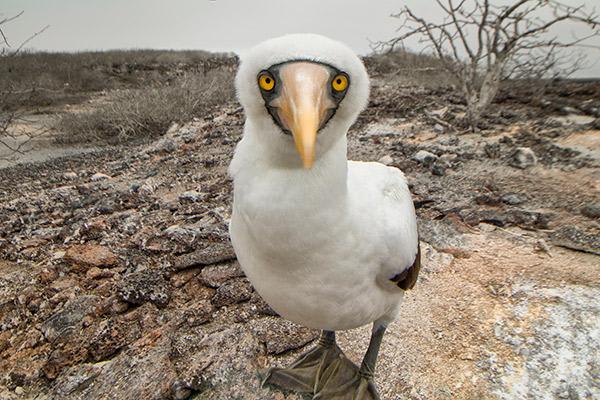
Cormorant Point, Post Office Bay & The Baroness’ Lookout
AM: Cormorant point is a visitor favorite, as it features two memorable beaches, a picturesque walk, and some interesting bird and plant life. Oddly enough, there are no Galapagos Cormorants here, but the flamingos make up for it! Visitors disembark on a sandy beach, which is greenish because of the special sand only found here.
A short walk leads to a salty lagoon where flamingos feed and nest. An easy trail leads to a white sand beach on the other side of the point, this one wide and breezy. As you walk, your guide may point out the two species of plants that are only found here: Scalesiavellosa and Lecocarpuspinaffitidus. Lucky visitors will see stingrays in the gentle surf, or even sharks swimming a little further out.
The stingrays make swimming here dangerous, but it is possible to wade in the shallows and take a stroll down the length of the beach. Look for Sally Lightfoot Crabs in rocky areas on both sides of the point. Snorkeling at Champion Islet is considered one of the best places for snorkeling with a great variety of underwater wildlife. It is also the home of the Floreana Mockingbird, one of the species in danger of extinction.
PM: Long before the Galapagos Islands were a bucket-list travel destination, it was a common stop for grand wooden seafaring vessels such as whalers. The sailors placed a barrel a short way from a sheltered bay on Floreana Island and used it to drop off and receive letters from home. Today, the yachts that serve the Galapagos are proud to continue this tradition: drop off letters and postcards in the barrel, and some other traveler will deliver them for you! Once you’ve flipped through the letters to see if there are any for your neck of the woods, you can enjoy some sun and sand on the small beach where passengers embark and disembark from the landing craft.
In the early 1930s, Floreana Island was home to Eloise Wehrborn de Wagner-Bosquet, a beautiful young Austrian woman, and her two lovers. Calling herself “the Baroness of Galapagos,” she quickly became an international sensation. She disappeared in 1934, a case that remains unsolved to this day. The visit to the site includes a short panga ride – look for sea life like rays and turtles. There are red mangroves along the shore: these mangroves are crucial to the island ecosystem.
Once on land, a dusty trail winds steadily upwards. The lookout point itself is a rocky hill of rugged volcanic rock, and there is indeed a good view from there, a reward for those who scramble to the top. A short walk away is the ruins of an old biological station, which were likely used in 1934 when some passing filmmakers made a short film starring the Baroness herself.
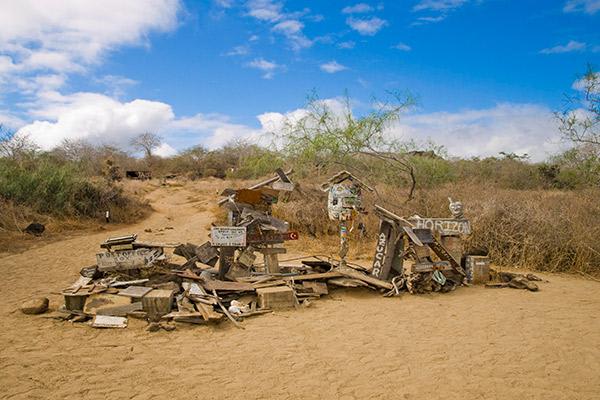
Mosquera Islet & Charles Darwin Research Station
AM: Located between the islands of Baltra and North Seymour, Mosquera is one of several tiny islets in the Galapagos. Sandy and rocky, it is not home to much in the way of vegetation, but it is very popular with sea lions and birds, including gulls. You can also expect to see marine iguanas sunning themselves on the rocks and colorful Sally Lightfoot crabs scuttling about in the tidal pools. Shorebirds are fond of the island: look for them trotting along the beach. There is some good snorkeling around Mosquera and dive shops in Puerto Ayora.
PM: The Fausto Llerena Giant Tortoise Breeding Center is managed by the Galapagos National Park Service and biologists from the Charles Darwin Research Station. The purpose of the center, named for a legendary park ranger, is to raise Galapagos tortoise hatchlings in a protected environment. When the tortoises are large enough to fend for themselves, they are released into the wild. The program has been a great success and in recent years hundreds of young tortoises have been released on several islands. You will see different sub-species of tortoises in various species of development, from tiny young ones smaller than your fist to fully-grown behemoths lumbering about their enclosures. Your guide will accompany you and provide information about the programs and facilities. The breeding center is located at the Charles Darwin Research Station, just outside of the town of Puerto Ayora. In addition to the tortoises, you may see finches, warblers, and other birds in and around the tall tree cacti, and tiny lava lizards scurrying about underfoot. After visiting the Research Station, passengers will be taken to the Puerto Ayora pier to board the M/C Elite.
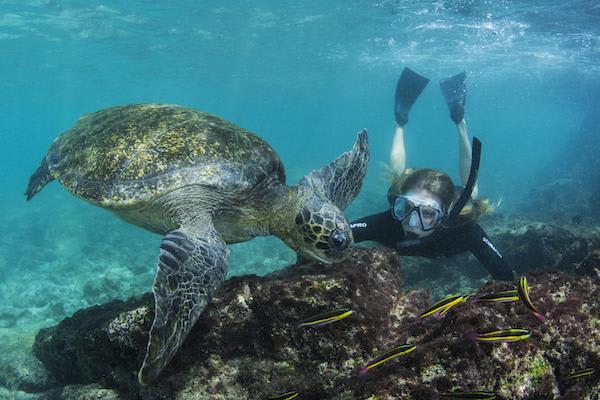
Prince Philip's Steps, El Barranco & Darwin Bay
AM: Genovesa Island is famous for birdlife and neither of its two visitor sites disappoints. Genovesa is the remnant of a once-mighty volcanic crater, and the island still has a distinctive crescent shape. The body of water formed by the crescent is called Darwin Bay, in spite of the fact that Charles Darwin did not ever visit this particular island.
There are no large land animals on Genovesa: not even tortoises or land iguanas. Unlike other islands, Genovesa never had a problem with destructive introduced animals like feral cats or goats, which has allowed birdlife to thrive unmolested on the island for millennia. In the morning, you will visit the Prince Philip’s Steps site. Getting to the visitor site from the landing area is tricky and involves a bit of climbing skill, but once you’re up, Prince Philip’s Steps is a visitor favorite.
There is a magnificent view from the upraised plateau, especially on a clear day. An easy trail winds through a low, scrubby forest and ends up at a rocky ravine of sorts, where lucky visitors will spot the rarely-seen Short-eared Owl. Visitors may also see Red-footed Boobys, gulls, or other birds nesting or visiting the site.
PM: The Darwin Bay visitor site is on the interior side of the crescent-shaped island, protected from wind and currents. It is a wide, sandy beach with a short trail that leads off to one side of the beach and up into some rocky formations. There are many bird species here: visitors can expect to see Blue-footed Boobys, Frigate Birds, Lava Gulls, Herons, Swallow-tailed Gulls, and more.
It is one of the few visitor sites in the islands where you can see Red-footed Boobys. There are some tidal pools off the trail: lucky visitors may spot a ray or some fish trapped there until the tide returns. Following the visit, guests will get to snorkel in the sheltered waters of the bay. Although deep water currents can sometimes cause the water to be chilly or cloudy, the crescent shape of the island protects the bay from strong winds.
The bluffs along the side of the bay drop sharply into the water, which means that snorkelers can stay close to shore but still have deeper water off to one side. Lucky snorkelers might see sharks, rays, sea lions, sea turtles, and dazzling reef fish including parrotfish, wrasses, king angelfish, and damselfish.
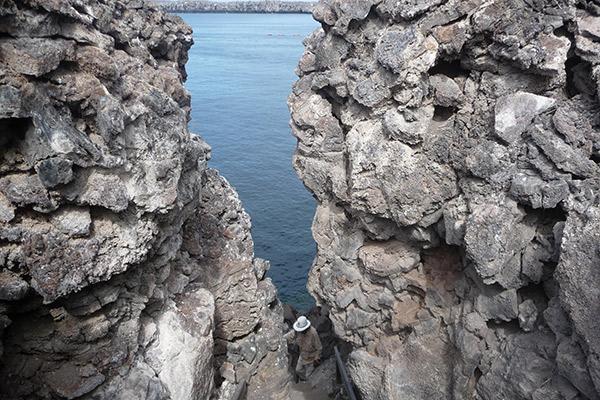
Buccaneer Cove, Espumilla Beach & Egas Port
AM: Back in the days of the great sailing ships, the Galapagos Islands were well known as a place where a traveling ship could stock up on food and water. Among the visitors were pirates, and the sheltered bay now known as Buccaneer Cove was a favorite place for them to repair their ships. Your visit includes a panga ride along the coast, where guests will see some interesting rock formations as well as several species of nesting birds including gulls, boobys, and pelicans. The formations, eroded into the colorful red rock, are quite striking. You may get to see not only sea lions but also their more reclusive cousins, the Galapagos Fur Sea Lion. The panga ride is followed by a visit to unforgettable Playa Espumilla (“Foamy Beach” in English). The beach, known for reddish sand, is a favorite among guests: long, pristine, and beautiful, it is home to a colony of sea lions as well as countless crabs and marine iguanas. It is possible to do some light snorkeling off of the beach.
PM: The human history of the Galapagos Islands is often as interesting as the natural history, and a good example is Port Egas. Decades ago, an Ecuadorian named Hector Egas tried to make his fortune mining salt on Santiago Island. It worked for a while, but in the end, the enterprise failed. Port Egas bears the name of this intrepid entrepreneur, and there are still some remnants of the old salt mine facilities here if you know where to look.
Puerto Egas is a superb visitor site even without its history. The trail is a loop that goes through some low trees before swinging around along the coast. Along the inland part of the trail, look for finches and a medium-sized blackbird: this is the Smooth-Billed Ani, an introduced species which somehow arrived in Galapagos at some point in the 1960s. On the coastal portion of the trail, you can expect to see numerous sea lions, marine iguanas, and shorebirds.
The coast is rocky due to its volcanic formation, but easy enough to walk along. Look in the shallow tidal pools: you never know what might have gotten stranded in there when the tide went out, and you might spot a stingray or an octopus in addition to the small fish usually found there.
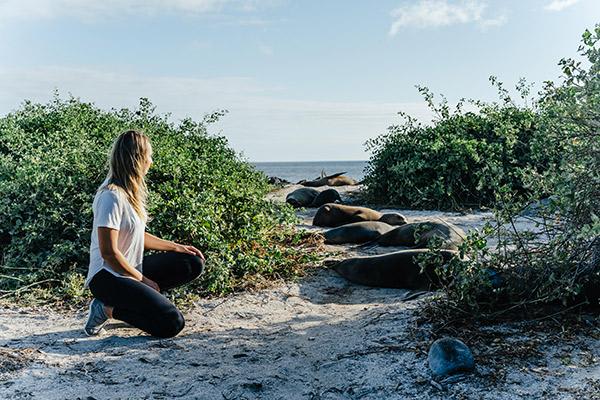
Bachas Beach, Twin Craters & Santa Cruz Highlands
AM: Bachas beach is one of the more beautiful ones in all of Galapagos – and that’s saying something. It is a long stretch of pristine white sand where sea lions lounge and crabs scuttle back and forth. It was used by the Americans during World War Two: “Bachas” is a version of the word “barges,” which were once landed here.
Sea turtles nest in some of the dunes here, and your guides will ask you to stay clear of the marked areas so as not to disturb the eggs. A short distance away are two salty lagoons where flamingos are frequently seen. There is no real hike here: only the warm, sandy beach. After a stroll along the sand and a refreshing dip, some of our guests like to do some easy snorkeling in the gentle surf.
PM: The Twins: The “twins” are a pair of sinkholes located in the highlands of Santa Cruz Island. Created ages ago by collapsing lava tunnels, they are not far from the main road through the highlands. From the parking lot, it is a fun, easy hike through a lush tropical forest to the walkways which ring the top of the sinkholes. Butterflies and smaller birds such as finches, doves, and mockingbirds dart and flit through the dense forest on either side of the trail, and attentive visitors may spot the distinctive red flash of a vermillion flycatcher as well.
You will stay in the highlands of Santa Cruz island to see giant tortoises in the wild. This impressive animal gives the name to the archipelago. You can easily appreciate the Galapagos giant tortoises in their natural habitat, eating, walking among others. This is also a good place to see birds such as short-eared owls, Darwin’s finches, yellow warblers, Galapagos rails, and paint-billed crakes. As part of this experience, you will visit underground lava tubes formed by cooled and solidified lava. Then we will continue our journey to board the M/C Elite.
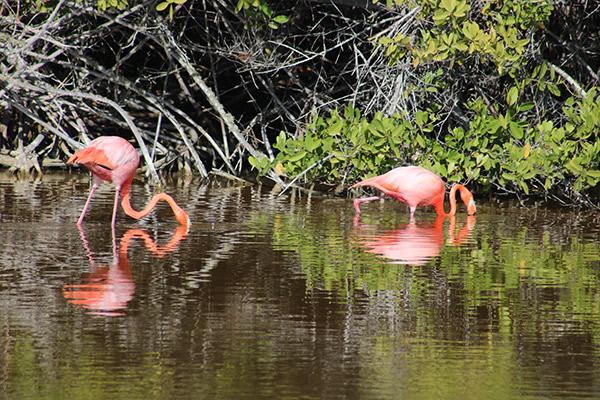
Disembarkation
AM: They say your culture influences the way you look at things, and Kicker Rock may just be the proof of that. Kicker Rock is a distinctive, boot-shaped rock formation located off of San Cristobal Island. In English, it gets its name from this shape. In Spanish, its name is “León Dormido,” or “Sleeping Lion.” Does it look more like a boot or a lion? You’ll get a nice close-up chance to look for yourself and make up your mind. Your final visit to the Galapagos Islands will be a memorable one: a panga ride up to and around the rock, with the chance for some snorkeling as well. The snorkeling here is excellent, although the currents can be rather strong. Hammerhead sharks are often seen in the murky depths around kicker rock, and fortunate snorkelers might even see a large ray or two.
We will disembark from the cruise at 8:00 AM from San Cristobal Port. After our early morning visit, passengers will get ready and then be taken to San Cristobal Airport. Our airport personnel will assist passengers with the check-in process. Farwell and boarding the flight back to mainland Ecuador.
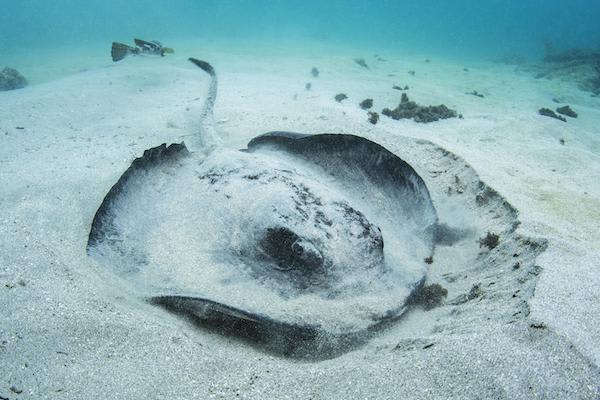
Accommodations
Social Areas









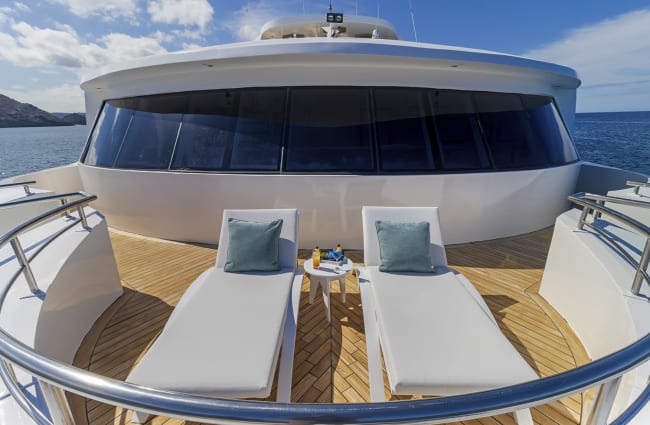

Suites & Cabins







Golden Suite
The suites feature a panoramic window that lets you enjoy the ocean view from the ensuite living area or the private balcony. There are two double suites on the main deck and one double cabin on the upper deck interconnected to accommodate families or friends traveling together.
Related Cruises
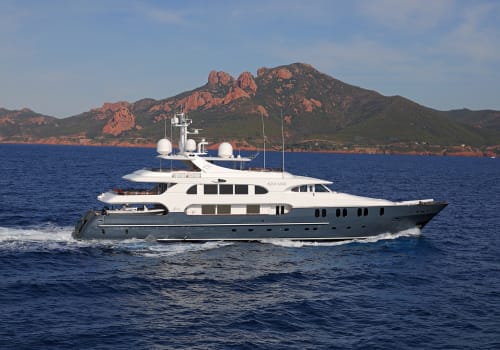
- Galapagos
- Ecuador
Aqua Mare

- Galapagos
- Ecuador
Cormorant II

- Galapagos
- Ecuador
Galaxy Sirius
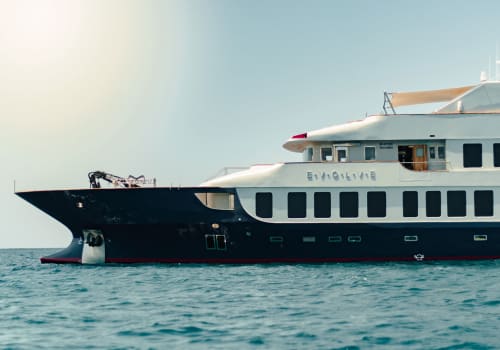
- Galapagos
- Ecuador
Origin, Theory & Evolve
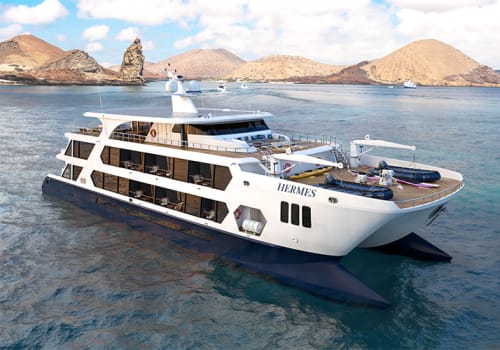
- Galapagos
- Ecuador
Hermes
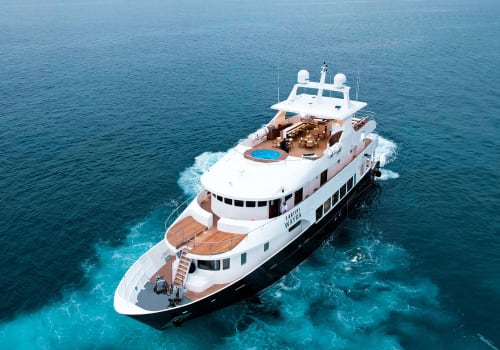
- Ecuador
- Costa Rica
Kontiki Wayra
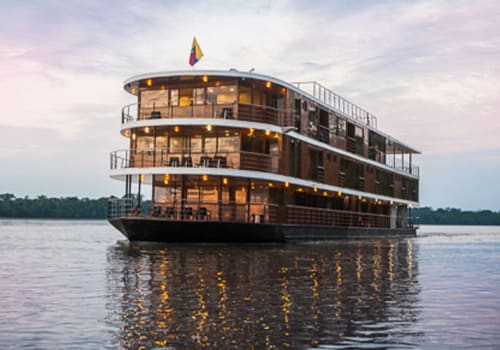
- Amazon
- Ecuador
Anakonda
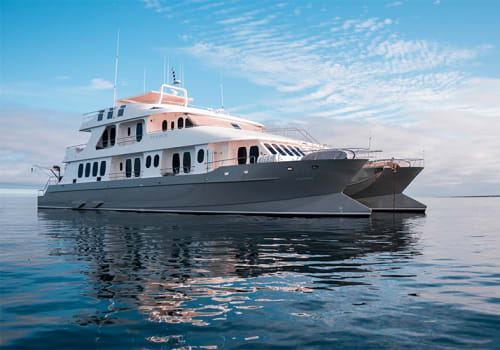
- Galapagos
- Ecuador
Alya
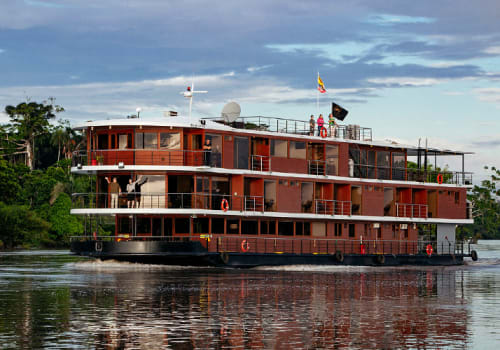
- Amazon
- Ecuador
Manatee Amazon Explorer

- Galapagos
- Ecuador
Endemic
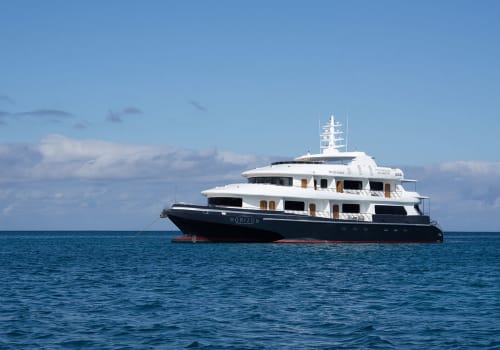
- Galapagos
- Ecuador
Galapagos Horizon
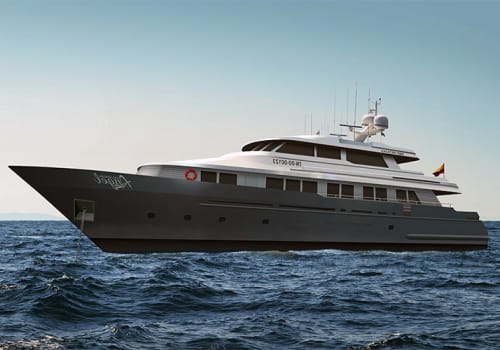
- Galapagos
- Ecuador
Galapagos Angel

- Galapagos
- Ecuador


